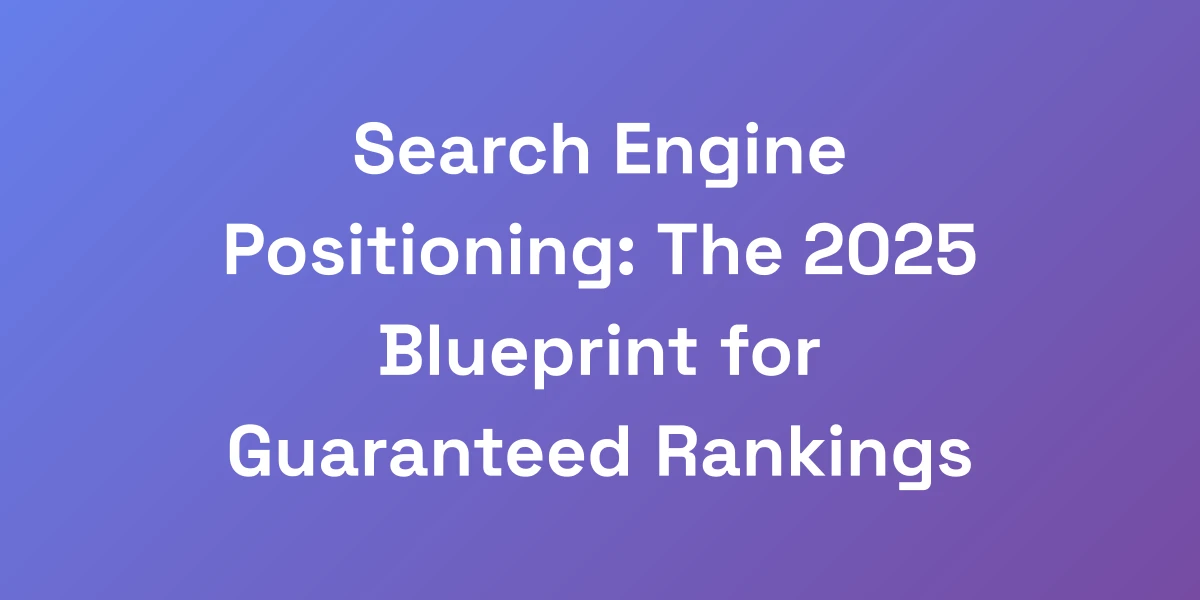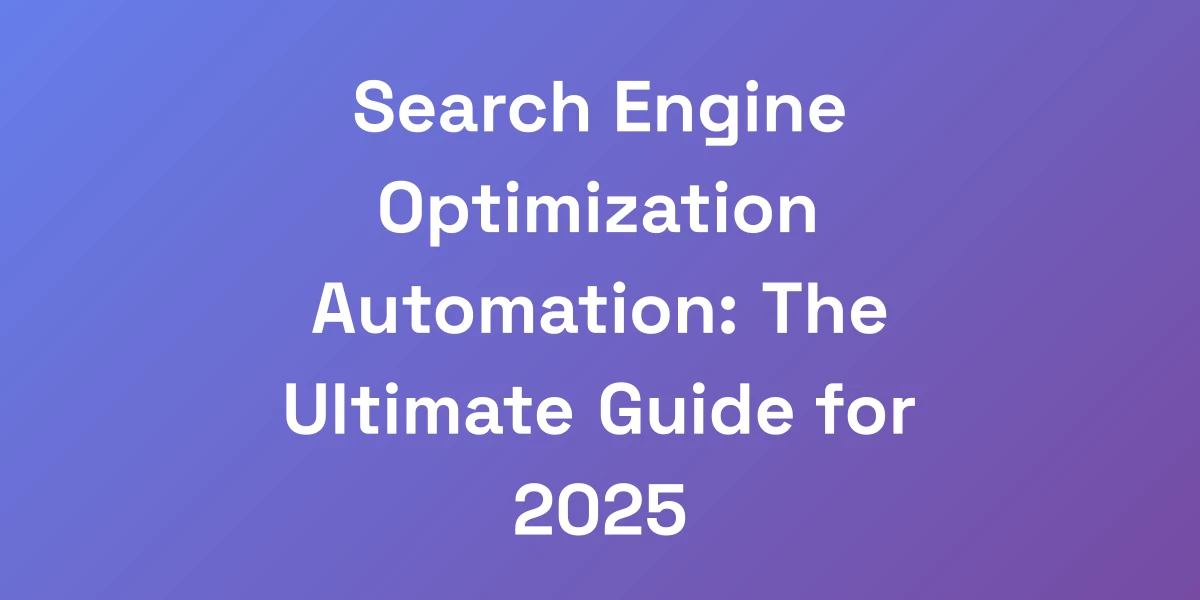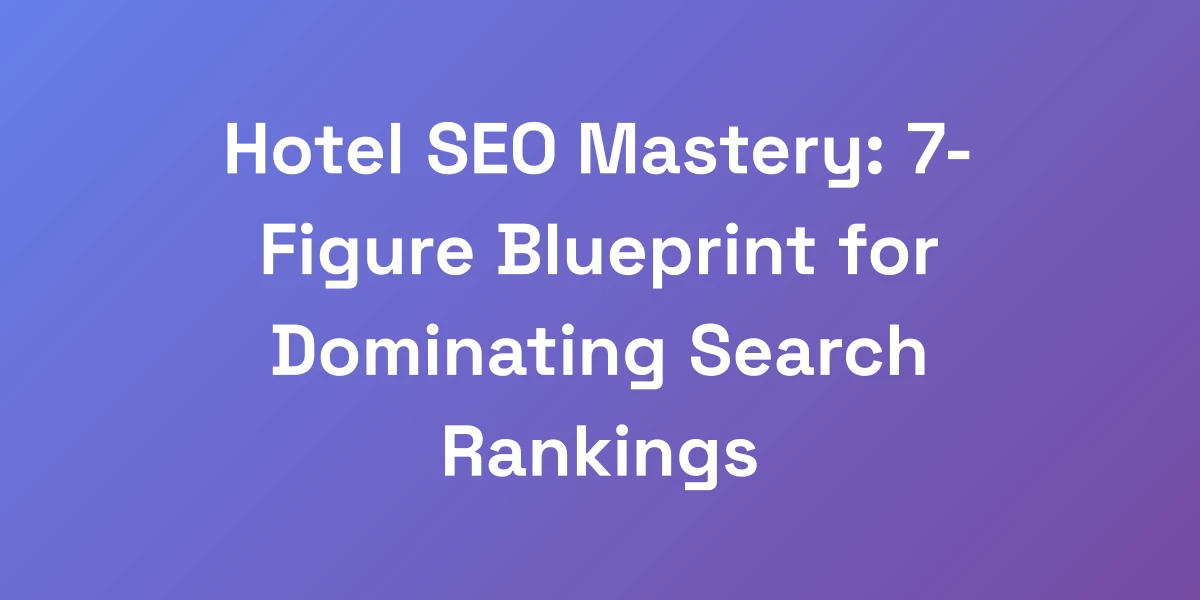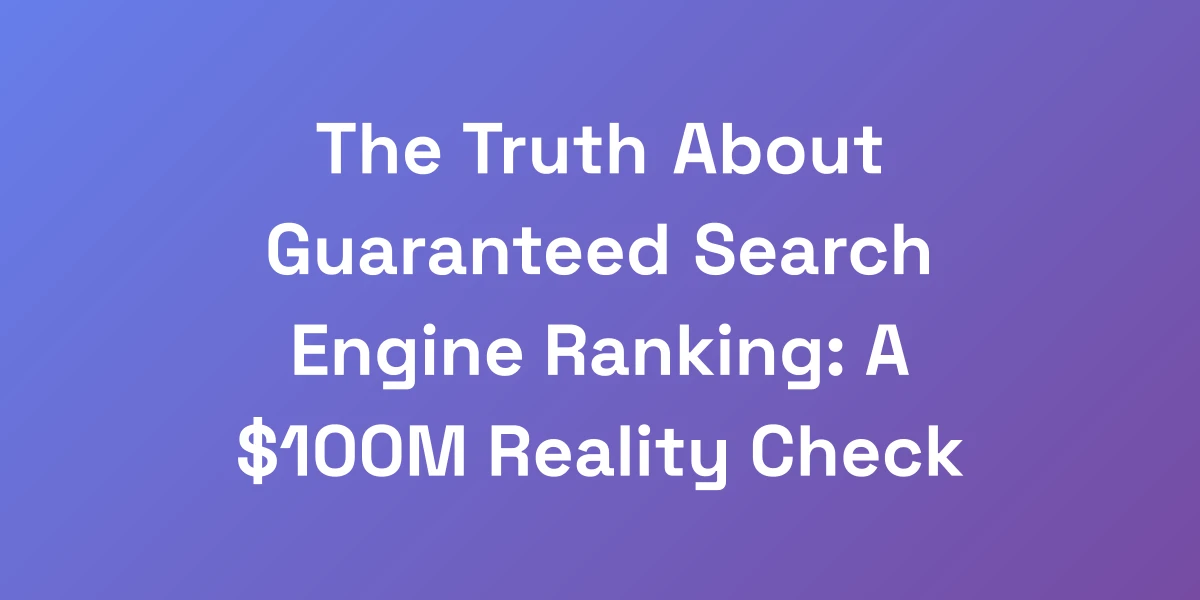
Search Engine Positioning: The 2025 Blueprint for Guaranteed Rankings
Mar 11, 2025 | By [email protected]
Understanding the Power of Search Engine Positioning in 2025
Let me cut through the BS and tell you what search engine positioning really is in 2025. It’s not just about ranking—it’s about dominating your market.
When 67% of all clicks go to the top 5 results, you’re either winning or you’re invisible.
We’ve helped businesses go from zero to millions by mastering this game. The rules have changed, and if you’re still using outdated tactics, you’re leaving money on the table.
Let’s break down exactly what works now and how to implement it for maximum ROI.
The Evolution of Search Engine Positioning
Search engine positioning has evolved dramatically over the past decade. Gone are the days when keyword stuffing could catapult a site to the top. Today, it’s all about quality, relevance, and user experience.
In 2025, algorithms have become more sophisticated, leveraging AI to understand user intent better than ever before. This means that content quality and engagement metrics are now paramount.
Take the Edelweiss Bakery case study, for instance. They increased organic traffic by 214% within four months by optimizing on-page elements, conducting technical audits, and building backlinks. This holistic approach is the new standard.
So, how did we get here? The integration of AI in search algorithms has shifted the focus from mere keywords to comprehensive content strategies that align with user needs and behaviors.
Why Traditional SEO Advice is Failing You
Traditional SEO advice often falls flat because it doesn’t account for the latest algorithm updates. Strategies like keyword stuffing, backlink spamming, and ignoring mobile optimization are antiquated and ineffective.
Google’s 2024 Core Updates have refined how authority and trustworthiness are assessed, resulting in a 40% reduction of unhelpful content. If you’re still relying on old-school tactics, you’re not just falling behind—you’re invisible.
Consider the Learning with Experts platform. They boosted organic sessions by 59% and revenue by 94% through targeted keyword research and site optimization. This wasn’t some magic trick; it was a strategic overhaul in response to evolving SEO landscape.
It’s time to abandon outdated methods and embrace search engine positioning tips that align with current search engine expectations.
The Direct Impact on Your Bottom Line
Search engine positioning isn’t just a technical challenge—it’s a direct driver of revenue. The top positions in SERPs capture the lion’s share of traffic, and with increased visibility comes increased conversions.
Think about The CBD Supplier, which saw a 557% growth in search traffic within a year by focusing on long-tail keywords and improving internal linking. This kind of growth translates directly into sales and profits.
Moreover, with zero-click searches on the rise, optimizing for featured snippets ensures you capture as much of the available traffic as possible. It’s not just about being seen; it’s about being chosen.
Your search positioning strategy is directly linked to your revenue streams. The better you rank, the more opportunities you have to convert visitors into customers.
Key Components of Modern Search Positioning
Modern search positioning is multifaceted, encompassing several key components that work together to enhance your visibility and authority online.
- Technical SEO: Ensuring your website is fast, secure, and mobile-friendly.
- Content Quality: Creating valuable, relevant, and engaging content that meets user intent.
- Link Building: Acquiring high-quality backlinks from reputable sources.
- User Experience: Optimizing the user journey to reduce bounce rates and increase engagement.
- Keyword Strategy: Implementing strategic keyword targeting and semantic search optimization.
Each of these components plays a critical role in your overall search positioning strategy. Neglecting any one aspect can hinder your ability to rank effectively.
Understanding Google’s Current Ranking Factors
Google’s ranking factors are constantly evolving, influenced by algorithm updates and changes in user behavior. As of 2025, some of the most significant factors include:
- Page Speed: Fast-loading pages provide a better user experience and are favored by Google.
- Mobile-first indexing: With mobile-first indexing, ensuring your site performs well on mobile devices is crucial.
- E-A-T (Expertise, Authority, Trustworthiness): Content that demonstrates expertise and builds trust ranks higher.
- Content Relevance: Content must closely match the search intent behind queries.
- Backlink Quality: High-quality backlinks from authoritative sites boost your site’s credibility and ranking.
Understanding and optimizing for these factors is essential for maintaining and improving your search engine positioning.
The Three Pillars of Dominant Search Engine Positioning
After analyzing thousands of websites and spending millions on testing, we’ve identified the three core elements that actually move the needle in search positioning. These aren’t theory—they’re battle-tested strategies that have generated consistent results across multiple industries.
Most “experts” overcomplicate this process. We’re going to show you exactly what matters and what’s just noise. Focus on these pillars, and you’ll see results faster than 90% of your competitors.
Technical Foundation: Speed and Structure
A solid technical foundation is non-negotiable. Your website must be fast, secure, and well-structured.
- Page Speed: Slow-loading pages drive users away and hurt your rankings. Tools like Google’s PageSpeed Insights can help identify and fix speed issues.
- Mobile Optimization: With mobile-first indexing, ensure your site is fully responsive and offers a seamless experience on all devices.
- Site Structure: A clear, logical structure helps both users and search engines navigate your site effectively. Implementing a clean URL structure and XML sitemaps is essential.
- Security: HTTPS is a must. A secure site builds trust with users and is favored by Google.
Take Iowa Girl Eats, for example. By implementing recipe schema markup and optimizing site speed, they achieved a 508% growth in three months. This showcases the importance of a robust technical foundation.
Modern SEO optimization automation tools can further enhance these efforts by automating repetitive technical tasks, ensuring your site remains optimized continuously.
Content Authority: Creating Magnetic Pages
Content is king, but authority is queen. Creating authoritative content that resonates with your audience is crucial.
- Comprehensive Content: Cover topics in-depth to answer all possible user queries. Flyhomes expanded its website to over 425K pages, resulting in a staggering 10,737% traffic growth.
- Expertise: Demonstrate your expertise through well-researched and accurate content. MedPark Hospital achieved a 523% year-over-year growth by tailoring content for both local and global audiences.
- Engagement: Engage your audience with compelling narratives and actionable insights. Learning with Experts boosted revenue by 94% with targeted optimization.
- Data-Driven Content Marketing: For small businesses, adopting a data-driven content marketing approach can maximize ROI and ensure content aligns with business objectives.
Creating magnetic pages means producing content that not only attracts visitors but also keeps them engaged and encourages sharing.
Incorporating AI-powered autoblogging can help scale content creation while maintaining quality.
User Experience Signals
User experience (UX) is a critical ranking factor. Google measures how users interact with your site, and positive signals can boost your rankings.
- Bounce Rate: A high bounce rate indicates poor UX. Ensure your site is easy to navigate and provides valuable content to keep users engaged.
- Time on Page: The longer users stay, the better. Create engaging content that encourages users to spend more time on your site.
- Mobile Usability: Ensure your site is fully functional on mobile devices. Poor mobile UX can lead to lost traffic and lower rankings.
By focusing on UX, you’re not just pleasing Google—you’re creating a better experience for your users, which translates into higher engagement and conversions.
Strategic Keyword Targeting
Keywords are still important, but the strategy has evolved. It’s now about targeting the right keywords that align with user intent.
- Long-Tail Keywords: Focus on specific, long-tail keywords that have less competition and higher conversion rates. The CBD Supplier saw a 557% growth in search traffic by targeting long-tail keywords.
- Semantic Search: Optimize for related terms and entities to enhance content relevance. Entity-based SEO helps search engines understand the context of your content.
- Voice Search Optimization: With the rise of voice search, consider conversational keywords and questions users might ask. Voice search optimization is becoming increasingly vital.
Effective keyword targeting requires a nuanced approach that considers not just the keywords themselves, but the intent and context behind them.
Link Authority Building
Backlinks remain a cornerstone of SEO. However, quality trumps quantity.
- High-Quality Backlinks: Focus on acquiring backlinks from reputable, authoritative sites in your industry. This boosts your site’s credibility and authority.
- Content Marketing: Create shareable content that naturally attracts backlinks. Infographics, research reports, and in-depth guides are great for this.
- Avoid Toxic Links: Steer clear of low-quality or spammy backlinks that can harm your site’s reputation and rankings.
Edelweiss Bakery’s success in increasing organic traffic by 214% was largely due to their strategic backlink building from high-authority sources, reinforcing the importance of this pillar. Tools like automated SEO tools can help efficiently identify high-quality backlink opportunities and manage outreach campaigns.
Implementation Strategy: Your 90-Day Action Plan
Here’s the exact framework we use with our clients to achieve top positions in search results. This isn’t about creating content and hoping for the best. It’s about strategic execution with clear metrics and milestones.
We’re going to give you the same step-by-step system that’s generated millions in revenue. Follow this plan, and you’ll see measurable improvements in your search positions within 90 days.
Week 1-4: Foundation Building
The first month is all about laying a robust foundation.
- Technical Audit: Conduct a comprehensive audit to identify and fix technical issues like broken links, slow page speeds, and mobile usability problems.
- Keyword Research: Identify high-potential keywords that align with your business goals and user intent.
- Competitor Analysis: Analyze your top competitors to understand their strategies and find opportunities to outperform them.
- Site Structure Optimization: Ensure your site architecture is logical and SEO-friendly, with clear navigation and internal linking structures.
By the end of week four, your website should be in top technical shape, ready to support the content and authority strategies that follow.
Leveraging marketing automation for agencies can further streamline these processes, ensuring efficiency and scalability.
Week 5-8: Content Optimization
Now that the foundation is set, it’s time to optimize your content.
- Content Audit: Review existing content to ensure it meets quality standards and is optimized for target keywords.
- Content Creation: Develop new, high-quality content that addresses user needs and aligns with your SEO strategy.
- On-Page SEO: Optimize meta titles, descriptions, headers, and images to enhance relevance and visibility.
- Schema Markup: Implement structured data to help search engines understand your content better and improve chances of appearing in rich results.
During these weeks, focus on creating content that not only ranks but also engages and converts.
Week 9-12: Authority Scaling
Now it’s time to scale your authority and solidify your search positioning.
- Backlink Building: Reach out to authoritative sites for backlinks. Guest posting, partnerships, and PR can be effective here.
- Content Promotion: Actively promote your content through social media, email marketing, and other channels to increase visibility and attract backlinks.
- Local SEO: Optimize your site for local search if applicable, ensuring your business appears in local listings and maps.
- Monitoring and Adjustment: Continuously monitor your rankings and traffic, making adjustments as needed to stay on track.
By the end of 90 days, you should see significant improvements in your search rankings and overall online visibility.
Measuring Progress and KPIs
Measuring progress is crucial to understanding the effectiveness of your strategy.
- Organic Traffic: Track the number of visitors coming from search engines to gauge visibility improvements.
- Keyword Rankings: Monitor your rankings for target keywords to assess your positioning strategy.
- Conversion Rates: Measure how effectively your traffic is converting into leads or sales.
- Engagement Metrics: Look at metrics like bounce rate, time on page, and pages per session to evaluate user experience.
Regularly reviewing these KPIs will help you stay informed and make data-driven decisions to optimize your strategy further.
Common Pitfalls to Avoid
Even the best strategies can falter if you fall into common SEO pitfalls.
- Ignoring Mobile Optimization: With mobile-first indexing, neglecting mobile users can severely impact your rankings.
- Overlooking Technical SEO: Technical issues can undermine your entire strategy. Ensure your site is free from errors and optimized for speed and usability.
- Neglecting Content Quality: Poorly written or irrelevant content can hurt your authority and rankings.
- Chasing Rankings Over Relevance: Focus on providing value and meeting user intent rather than just chasing keyword rankings.
- Inconsistent Monitoring: Failing to regularly monitor your performance can lead to missed opportunities and unresolved issues.
By being aware of these pitfalls, you can proactively avoid them and ensure your SEO strategy remains effective.
Advanced Tactics for Competitive Markets
Want to know what separates the top 1% from everyone else? It’s not just about working harder—it’s about leveraging advanced positioning strategies that your competitors don’t know about.
We’re talking about techniques that can double or triple your organic traffic in competitive markets. These are the same strategies we use to dominate high-value keywords in saturated industries.
Entity Optimization for Knowledge Graph
Entity optimization is about making your content more understandable to search engines by focusing on the relationships between entities.
- Comprehensive Entity Mapping: Identify and map key entities related to your niche to provide search engines with meaningful context.
- Structured Data: Use schema markup to define entities and their relationships, enhancing your chances of appearing in the Knowledge Graph.
- Content Enrichment: Enrich your content with related entities to create a web of interconnected information that search engines can easily interpret.
By optimizing entities, you’re helping search engines understand your content’s context, which can significantly boost your visibility in the Knowledge Graph.
Featured Snippet Targeting
Featured snippets are prime real estate on the SERPs, often appearing above the top organic results.
- Answer Queries Directly: Structure your content to answer questions concisely and clearly, increasing the likelihood of being featured.
- Use Structured Formats: Employ lists, tables, and definitions where appropriate to fit the snippet format.
- Optimize for Position Zero: Target specific queries that are likely to trigger featured snippets by understanding user intent.
Optimizing for featured snippets can dramatically increase your visibility and drive more traffic to your site.
Voice Search Optimization
With the rise of voice-activated devices, voice search optimization is no longer optional.
- Conversational Keywords: Incorporate natural language and long-tail keywords that reflect how people speak.
- FAQ Pages: Create comprehensive FAQ sections that address common voice search queries.
- Featured Snippets Integration: Since many voice searches pull from featured snippets, optimizing for snippets also benefits voice search.
By tailoring your SEO strategy to include voice search, you can tap into a growing segment of search traffic.
Local Search Domination
Local search is critical for businesses that serve specific geographic areas.
- Google My Business Optimization: Ensure your Google My Business profile is complete and optimized with accurate information.
- Local Keywords: Incorporate location-specific keywords into your content to attract local traffic.
- Local Reviews: Encourage satisfied customers to leave positive reviews, boosting your local credibility and rankings.
Mastering local SEO ensures that your business stands out in local search results, driving more foot traffic and local engagement.
Mobile-First Positioning
With mobile-first indexing, ensuring your site is optimized for mobile devices is essential.
- Responsive Design: Implement a responsive design that adapts seamlessly to all screen sizes.
- Fast Load Times: Optimize images, leverage browser caching, and minimize code to ensure quick load times on mobile.
- Mobile UX: Design with mobile users in mind, ensuring easy navigation, readable text, and accessible buttons.
A mobile-first approach not only improves your rankings but also enhances the user experience for the majority of your visitors.
Scaling and Maintaining Your Search Positions
Getting to the top is one thing—staying there is another game entirely. We’ve seen too many businesses crash and burn because they didn’t have a proper maintenance strategy.
Here’s the exact system we use to protect and scale our search positions. This is about building a sustainable competitive advantage that keeps delivering results month after month.
Content Update Strategy
Keeping your content freshness and relevant is key to maintaining your rankings.
- Regular Updates: Schedule regular reviews of your content to update outdated information and add new insights.
- Expand Content: Continuously expand your content to cover new aspects of your topics, keeping it comprehensive and authoritative.
- Refresh Headlines and Meta: Update headlines and meta descriptions to align with current trends and keywords.
By maintaining a content update strategy, you ensure your site remains relevant and valuable to both users and search engines.
Competitor Monitoring
Keeping an eye on your competitors is crucial for staying ahead in the SEO game.
- Track Competitor Rankings: Monitor where your competitors are ranking for your target keywords and identify opportunities to outrank them.
- Analyze Their Strategies: Study your competitors’ content, backlink profiles, and social strategies to understand what works for them.
- Identify Gaps: Look for gaps in their strategies that you can capitalize on to gain a competitive edge.
By continuously monitoring your competitors, you can adapt and refine your strategies to maintain your top positions.
Algorithm Change Protection
Google’s algorithms are constantly evolving. Protecting your rankings against these changes is essential.
- Stay Informed: Keep up-to-date with the latest algorithm updates and understand how they impact your SEO strategy.
- Flexible Strategies: Develop flexible SEO strategies that can quickly adapt to algorithm changes without sacrificing performance.
- Diverse Traffic Sources: Relying on multiple traffic sources reduces the risk of significant traffic drops due to algorithm changes.
Preparing for algorithm changes ensures that your search positions remain stable and your site continues to perform well.
Growth Opportunities
SEO is not a set-it-and-forget-it strategy. Identifying and capitalizing on growth opportunities is key to scaling your search presence.
- New Keyword Opportunities: Continuously seek out new keywords to target, especially those with growing search volumes.
- Content Diversification: Explore different content formats like videos, podcasts, and infographics to reach a wider audience.
- Emerging Trends: Stay ahead of industry trends and incorporate them into your content strategy to maintain relevance and authority.
By actively seeking growth opportunities, you ensure that your SEO strategy remains dynamic and continues to deliver long-term results.
Long-term Success Metrics
Measuring long-term success ensures that your SEO efforts continue to drive value over time.
- Consistent Organic Traffic: Track the sustainability and growth of your organic traffic over the long term.
- Stable Rankings: Monitor the stability of your keyword rankings, ensuring they remain high and consistent.
- Revenue Growth: Measure how SEO contributes to your overall revenue and business growth.
- Customer Retention: Evaluate how your SEO efforts help in retaining customers and building brand loyalty.
Focusing on these metrics helps you gauge the ongoing effectiveness of your SEO strategy and make informed decisions for future growth.
Conclusion
Search engine positioning in 2025 is a complex, dynamic field that demands a strategic, multifaceted approach. We’ve dissected the evolution of SEO, identified the three pillars of dominant positioning, and laid out a comprehensive 90-day action plan to transform your rankings.
By implementing a solid technical foundation, building authoritative content, and enhancing user experience, you can secure top positions in search results.
But it doesn’t stop there. Leveraging advanced tactics like entity optimization and featured snippet targeting can propel you into the elite 1%, while a robust maintenance strategy ensures your success is sustainable.
Ready to dominate your market and guarantee your search engine rankings? Let’s take action now. Start implementing these strategies today and watch your organic traffic and revenue soar.
What steps will you take to elevate your search engine positioning? Share your thoughts and experiences in the comments below—we’re in this together.




![Guaranteed SEO Services: The Truth Behind Rankings Promises [2025]](https://autoseo.eazyseo.co/wp-content/uploads/2025/03/Guaranteed-SEO-Services-The-Truth-Behind-Rankings.webp)



